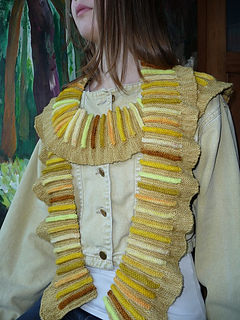patterns > Knitty >  Knitty, Spring + Summer 2013
Knitty, Spring + Summer 2013
> Steps








Steps
Shaping in knitting is usually achieved by using short rows or by increasing and/or decreasing the number of stitches. However, in this shawlish scarf (or scarfish shawl), shaping is achieved in a different way, namely by gathering together the stitches of part of the project, in order to create what look like steps. When these steps are created at regular intervals, a circular shape appears.
Apart from being a construction element, the steps also stand out as a visual element, especially when they are knitted in a contrasting color.
The pattern is easy to knit, it’s all garter stitch and you can use any type (or thickness) of yarn that you like for this pattern
Note that this pattern uses up more yarn than if you were to knit a regular garter stitch scarf or cowl – the steps use up lots more yarn that a flat fabric. In addition, the more color changes in the ridges, the more ends there are to weave in. But, having said that, I think that the advantage of making this very cool looking scarf outweighs the disadvantages by far!
I used fingering weight yarn for my project (Loret Karman Dutch Palettes ‘Sunflowers’), but you can knit this pattern with any type or thickness of yarn, the gauge doesn’t matter. Just decide how wide you want your scarf/shawlette to be, and then using the gauge information, calculate how many stitches you have to cast on to achieve this width. Then divide that roughly in thirds, working the step on the last two-thirds of the row. Length, of course, is easily adjustable.
The Intarsia method is used to work the color sections. Join CC at the point you need to start working it. Twist yarns around each other when changing colors.
132020 projects
stashed
146166 times
141 projects
stashed
56 times
- First published: March 2013
- Page created: March 7, 2013
- Last updated: October 20, 2013 …
- visits in the last 24 hours
- visitors right now




